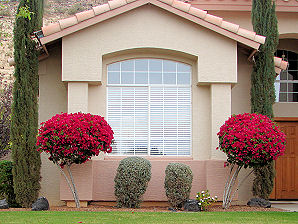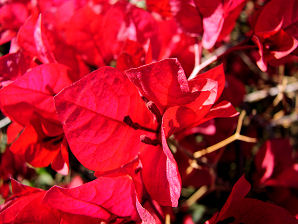Xeriscape Landscaping Plants For The Arizona Desert Environment.
Pictures, Photos, Information, Descriptions,
Images, & Reviews.
Vines.
Bougainvillea, Bougainvillea glabra.
We Are Proud Of Our SafeSurf Rating!
Click On Any Of The Following Links By Amazon.Com
For Books, & Videos About Wildflowers Of Arizona & The Southwest USA. No Obligation!
 |
| Bougainvillea glabra. Photo January 21, 2006. Arrowhead Ranch, Glendale, Arizona.. |
|---|
 | |
| Bougainvillea Vines. | Bougainvillea Flowers. |
|---|---|
 |  |
| Bougainvillea Flower. And Bracts. | The Actual Bougainvillea Flower. Bracts In Background. |
Bougainvillea.
We wish to thank Wikipedia, the free encyclopedia for some of the information on this page. We share images and information with Wikipedia. Bougainvillea is a genus of flowering plants native to South America from Brazil, west to Peru, and south to southern Argentina (Chubut Province). The first European to describe these plants was Philibert Commer�on, a French botanist accompanying the French Navy admiral and explorer Louis Antoine de Bougainville during his voyage of circumnavigation, and first published for him by Antoine Laurent de Jussieu in 1789. It is possible that the first European to observe these plants was Jeanne Bar�, Commer�on's lover and assistant whom he sneaked on board (despite regulations) disguised as a man (and who thus became the first woman to circumnavigate the globe). Bougainvillea is grown extensively in the warmer climates of the United States. It grows very well in Arizona. It can be grown as a hedge, groomed as a ground cover, pruned as an espalier, trained as a tree or contained in a pot in a variety of shapes. It comes in many colors. i.e. Purple, lavender, carmine, scarlet, red, pink, orange, yellow and white. Single and double flower forms are available. Its bracts appear on the ends of new growth. The colorful, papery "blooms" are not flowers; they are bracts. The true flower is white to pink, trumpet shaped and almost unnoticeable within the bracts. Bougainvilleas are available in a variety of species, each having its unique characteristics. It is a very showy plant. It is truly one of the most beautiful plants we know of. But, it has one drawback. It has very high litter. Do not place one near a pool. If you plant one, your neighbors will hate you! We know many people who have removed the plants after a few years, due to the high litter.
Quick Notes:
Height: Height about 2 - 5 feet, sometimes higher. Spreading about 6 - 12 feet. Can reach over 30 feet.
Flowers: Very small, white, trumpet shaped and almost unnoticeable. Within showy bracts.
Flowering Time: Year round. Not too much in mid December - mid January.
Seed Pod: Thorny, globose, walnut-sized 1-1/2 inches in diameter with many small, slender spines.
Leaves: Dark green, shaped like little hearts with drip tips at the ends. Some are ovate to rounded, leathery and hairy underneath. Others are elliptical, wide in middle, hairy.
Found: Native to Brazil, Ecuador, Paraguay. The USDA claims it is native of the USA (FL, TX), USA+ (PR, VI).
Hardiness:
Soil pH requirements:
Sun Exposure:
Elevation: 0 - 2,500 feet.
Habitat: Well drained sandy desert soils, slopes, mesas, and disturbed rocky soil. Used in landscaping.
Miscellaneous: Photos Taken At January 21, 2006. Arrowhead Ranch, Glendale, Arizona. Very High Litter!
|
We Are Proud Of Our SafeSurf Rating!
Click On Any Of The Following Links By Amazon.Com
For Books, & Videos About Wildflowers Of Arizona & The Southwest USA. No Obligation!
| © 1966 - Present, Audrey, Eve, & George DeLange |
